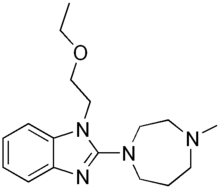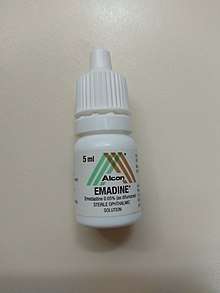Emedastine
Emedastine (trade name Emadine) is a second generation antihistamine used in eye drops to alleviate the symptoms of allergic conjunctivitis.[1] It acts as a H1 receptor antagonist. It works by blocking the action of histamine that causes allergic symptoms. It is used in form of the difumarate.[2] The emedastine difumarate is a white, crystalline, water-soluble fine powder. Emedastine eye drops is usually applied twice a day to the affected eye. When the patients with allergic conjunctivitis were treated with 0.05% emedastine difumarate ophthalmic solution for six weeks, the signs and symptoms such as redness, itching and swelling of the eyes were relieved. Emedastine appears to be devoid of effects on adrenergic, dopaminergic and serotonin receptors. This drug was developed by Alcon, which is global medical company specializing in eye care products.
 | |
| Identifiers | |
|---|---|
| CompTox Dashboard (EPA) | |

Pharmacodynamics
Emedastine is significantly selective to H1 histamine receptors (Ki = 1.3 nM), whereas its affinities for other histamine receptors were low (H2: Ki = 49067 nM and H3: Ki = 12430 nM) ub in vitro study. Topical ocular administration of emedastine inhibits histamine-stimulated vascular permeability in the conjunctiva as a concentration-dependent manner in in vitro study.
Pharmacokinetics
The human oral bioavailability is approximately 50% and maximum plasma concentration was achieved within 1–2 hours after dosing. Emedastine is mainly metabolized by the liver. There are two primary metabolites: 5-hydroxyemedastine and 6-hydroxyemedastine. They are excreted in the urine as both free and conjugated forms. The 5'-oxoanalogs of 5-hydroxyemedastine, 6-hydroxyemedastine and the N-oxide are also formed as minor metabolites. The elimination half-life of oral emedastine in plasma is 3–4 hours, whereas that of topical emedastine is 10 hours. Approximately 44% of the oral dose is recovered in the urine over 24 hours with only 3.6% of the dose excreted as parent drug.[3]
Contraindications
Emedastine should not be used in patients who are hypersensitive to emedastine or any other excipients of the preparation. Benzalkonium chloride contained in the bottle of emedastine solution can discolor soft contact lenses, so people who wear contact lenses should be careful using it.
Adverse events
The most common adverse effect was headache (11%). The other minor adverse effects encountered in less than 5% of patients were asthenia, burning or stinging sensation, unpleasant taste, blurred vision, eye dryness and tearing.
References
- "Emedastine (Ophthalmic)". The American Society of Health-System Pharmacists. Retrieved 11 February 2020.
- Bielory L, Lien KW, Bigelsen S (2005). "Efficacy and tolerability of newer antihistamines in the treatment of allergic conjunctivitis". Drugs. 65 (2): 215–28. doi:10.2165/00003495-200565020-00004. PMID 15631542.
- "Emadine (emedastine difumarate ophthalmic solution) 0.05%. Full Prescribing Information" (PDF). Alcon Laboratories, Inc. 6201 South Freeway Fort Worth, Texas 76134, USA. Retrieved 5 January 2016.